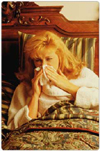|
 |
|
|
 |
|
Live life to the fullest though you have Asthma |
 |
|
Live life to the fullest though you have Asthma
12 January 2000 -- by Karon Ng
Asthma is the 10th principal cause of death in Singapore; in 1998, 20% of Singapore children demonstrated symptoms of asthma (Ministry of Health), and some 4% of the adult population in Singapore have asthma. It can be terrifying, both for the patient and the observer, for an attack is often characterised by wheezing and a desperate fight for air.
Although asthma cannot be cured, the likelihood of an attack can be reduced. With the proper precautions, treatment, and monitoring, an asthmatic can still live a normal, active and fulfilling life.
What triggers asthma?
The condition occurs when the airway narrows in response to stimuli such as pollens, dust mites, smoke, cold air, respiratory infection, exercise and even anxiety or excitement. In an attack, the smooth muscle layer of the bronchi go into spasm, and the inner lining inflames and increases mucus production into the airway. This results in the narrowing of the diameter of the airways and more effort is exerted to move air in and out, thus the characteristic wheezing of an asthmatic attack.
If left untreated, the supply of air to the lungs is increasingly limited, and one may turn blue (cyanosis) and ultimately die. The good news is that the constriction is reversible, and one normally recovers completely, even from a severe attack.
Precautions
To avoid triggering an attack, the asthmatic should: - avoid dusty and smoky surroundings;
- avoid irritating fumes such as cigarette smoke;
- avoid allergens that have previously affected the sufferer;
- seek prompt attention for coughs and colds;
- avoid exposure to house dust mites by e.g. cleaning and mopping the floor frequently, reducing wall-to-wall carpets and using special mattresses and pillow covers;
- avoid over-exertion.
 Treatment Treatment
There are two main groups of asthma medication: bronchodilators and preventive medicines. Bronchodilators widen the airways, and are best used for relieving sudden asthma attacks and preventing attacks that might arise from exercise.
Some examples are: - salbutamol (Ventolin)
- terbutaline (Bricanyl)
Preventive medicines help to prevent asthma in the long run, and they need to be taken regularly to reduce the number and severity of attacks.
Some examples are: - sodium cromoglycate (Intal)
- nedocromil sodium (Tilade)
- inhaled steroids (Becotide, Pulmocort)
These medications are delivered directly into the lungs through the use of inhalers. There's the metered dose inhaler, the powdered inhaler and the nebuliser, which is a small machine that converts liquid bronchodilator into small droplets that are breathed in through a face mask.
A device called the Peak Flow Meter is also used in cases of asthma to help monitor the condition and the effectiveness of the medication. The meter measures the maximum flow rate of air from the lungs; a low peak flow would mean that the asthma is not well controlled.
 A proper asthma management plan should only be drawn up with the doctor's advice and issued medication. However, by equipping oneself with the basics of the disease, the asthmatic is empowered to participate in the decision-making process and to take control of his/her life. A proper asthma management plan should only be drawn up with the doctor's advice and issued medication. However, by equipping oneself with the basics of the disease, the asthmatic is empowered to participate in the decision-making process and to take control of his/her life.
Finally, the asthmatic should know his limits, rest well, and always carry his prescribed medication with him. And he will be well on the way to an active, healthy and normal life.
References: - Berkow, Robert, M.D., Beers, Mark H., et al. 1999. The Merck Manual of Medical Information, New York: Merck & Co., Inc, p.188-191
- Hodgkin, Keith, BM, Bch, FRCGP, FRCP et al. 1983. Family Medical Adviser: An A-Z guide to everyday ailments, their symptoms, causes and treatment, London: The Reader's Digest Association Limited, p.80
- Ministry of Health website, Singapore
- American Academy of Allergy, Asthma & Immunology website
Date reviewed: 13 January 2000
|
 |
| |
 |
|
|
 |
 |
|
|
|